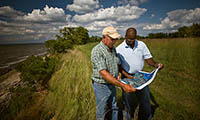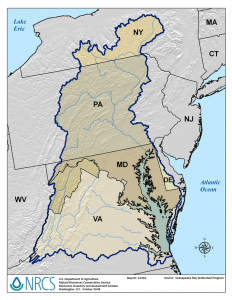USDA Invests $22.5M for Chesapeake Bay Water Quality
 The U.S. Department of Agriculture will invest an additional $22.5 million in conservation assistance in fiscal year 2022 to help farmers boost water quality improvements and conservation in the Chesapeake Bay watershed. The new Chesapeake Bay States’ Partnerships Initiative will support Bay-area farmers, building on a $1.1 billion investment made by USDA’s Natural Resources Conservation Service over the past decade. USDA is also announcing a new task force – jointly with the U.S. Environmental Protection Agency – to better quantify the voluntary conservation efforts of farmers in the Bay watershed.
The U.S. Department of Agriculture will invest an additional $22.5 million in conservation assistance in fiscal year 2022 to help farmers boost water quality improvements and conservation in the Chesapeake Bay watershed. The new Chesapeake Bay States’ Partnerships Initiative will support Bay-area farmers, building on a $1.1 billion investment made by USDA’s Natural Resources Conservation Service over the past decade. USDA is also announcing a new task force – jointly with the U.S. Environmental Protection Agency – to better quantify the voluntary conservation efforts of farmers in the Bay watershed.
“Farmers in the Bay are voluntarily implementing conservation on their farms that is helping to curb sediment and nutrient loss and improve water quality in the Chesapeake Bay watershed,” said Robert Bonnie, under secretary for Farm Production and Conservation. “There is still more work to be done and USDA is committed to continuing to support Bay producers and harnessing the power of partnership to ensure meaningful and lasting improvements for the future.”
“For farmers here in south central Pennsylvania working to reduce nutrient runoff while facing a challenging economy, this USDA investment is a game-changer for developing practices to improve water quality in the Chesapeake Bay Watershed,” said Sen. Bob Casey (D-PA). “Farmers are leading stewards of the land and have a critical understanding of the best way to protect our waterways while simultaneously improving their bottom line.
“Thanks to USDA and the funding I secured in the recently passed spending bill, Pennsylvania farmers will receive increased and targeted conservation assistance, ensuring they prioritize cost-effective practices which restore water quality and improve on-farm resiliency. I’m going to keep working to ensure our state does its part to clean up the Bay, fight the climate crisis and support farmers.”
“I am pleased to celebrate my collaboration with Senator Casey to reduce upstream sources of nutrient loading to the Chesapeake Bay,” ,” said Sen. Ben Cardin (D-MD). “As Maryland’s largest economic sector, agriculture in many ways defines our state. Similarly, best agricultural practices telegraph the health of the Chesapeake Bay. So federal investments that enable the watershed’s farmers to implement conservation measures at scale – and in highly effective, cooperative ways – give us reason to take heart.
“Thanks to the science-driven, regional partnership that has guided us for decades, we have a road map to achieve our restoration goals. These new USDA investments in our farmers will move us significantly forward.”
 “The Chesapeake Bay is a national treasure and a regional economic engine that every state in the watershed has a responsibility to protect. In order to meet the goals of our Bay Agreement, we need all hands on deck,” said Sen. Chris Van Hollen (D-MD). “That’s why we fought to launch this new partnership which will support the Bay region’s farmers, bolster their conservation efforts, and help get us on track to reach our 2025 goals. Today we’re building on the partnership with the USDA and Bay state lawmakers to establish this regionwide effort that will add more momentum to our charge to protect the Bay for generations to come.”
“The Chesapeake Bay is a national treasure and a regional economic engine that every state in the watershed has a responsibility to protect. In order to meet the goals of our Bay Agreement, we need all hands on deck,” said Sen. Chris Van Hollen (D-MD). “That’s why we fought to launch this new partnership which will support the Bay region’s farmers, bolster their conservation efforts, and help get us on track to reach our 2025 goals. Today we’re building on the partnership with the USDA and Bay state lawmakers to establish this regionwide effort that will add more momentum to our charge to protect the Bay for generations to come.”
This new initiative exemplifies the approach of voluntary, locally led conservation that the Biden administration has prioritized through the America the Beautiful Initiative. The Chesapeake Bay States’ Partnership Initiative will provide a new and innovative framework to leverage USDA conservation financial and technical assistance, locally led conservation, and coordination with state partners.
For fiscal 2022, NRCS is providing $10 million from the Environmental Quality Incentives Program, $10 million from the Agricultural Conservation Easement Program and $2.5 million from the Conservation Stewardship Program.
NRCS will address resource concerns based on a locally led approach and continue to use a targeting process, developed by the NRCS State Technical Committee, to ensure funds are awarded to priority watersheds within the Chesapeake Bay watershed.
Through this Initiative, NRCS will prioritize support of practices that reduce nitrogen and sediment, improve management of livestock and waste, and conserve wetlands, all of which align with the Bay’s water quality objectives to reduce nutrient loading, restore wetlands and install riparian buffers. Practices include riparian buffers, cover crops, waste storage facilities, and prescribed grazing, among others.
This funding will allow states to respond to the high demand from Bay area farmers for additional conservation support, as well as offer new and targeted sign-ups. NRCS will also work with USDA’s Farm Service Agency to identify needs and opportunities for buffer management on acres that may be coming out of the Conservation Reserve Program.
In addition to the establishment of the new initiative and the additional funding for fiscal year 2022, USDA and EPA are establishing a new federal Task Force on Crediting Chesapeake Bay Conservation Investments. The Task Force will work over the next year to identify improvements to more fully credit farmers’ conservation efforts in cooperation with the Bay States and the agricultural community.
“We appreciate USDA’s extensive investments that support agricultural conservation efforts that benefit farmers, local streams, and the Chesapeake Bay, which is in addition to new watershed funding announced by EPA earlier this week from the Bipartisan Infrastructure Law,” said Adam Ortiz, EPA Mid-Atlantic Regional administrator. “EPA and USDA are united in our commitment to give farmers the credit they deserve. Together, we will work with our federal, state, and agricultural partners to find solutions that are supported by the Chesapeake Bay Program partnership’s process and accounting protocols.”
The Task Force will develop an action plan that is responsive to the needs of the Bay states and agricultural community. Solutions will maintain the scientific integrity of the Chesapeake Bay Program partnership’s decision-making process and accounting tools and ensure producer privacy is protected. The Task Force will leverage findings from successful data sharing pilots and look for opportunities to integrate time-saving technologies to identify conservation practice implementation.
Agricultural lands compose nearly 30 percent of the Chesapeake Bay watershed, which includes the District of Columbia and portions of Delaware, Maryland, New York, Pennsylvania, Virginia and West Virginia. This region has more than 83,000 farms responsible for more than $10 billion in agricultural production each year.
NRCS harnesses proven conservation practices and programs to help farmers improve their operations while at the same time improving water quality and conserving natural resources in the Bay watershed.
Between 2018 and 2020, NRCS helped farmers implement conservation on 1.26 million acres in the Bay watershed, which is the size of Grand Canyon National Park.
From 2006 to 2016, farmers in the Bay watershed made significant increases in the adoption of structural practices, conservation tillage, and cover crops that reduced sediment loss, surface losses of nitrogen and phosphorus from cropped fields and increased per acre carbon stored in cropland soils by 69 percent.
Across the Bay from 2006 to 2016:
- Application of edge-of-field practices nearly tripled, from 9.6 percent to 28.3 percent of cropland acres using a riparian buffer, field border, filter strip, or critical area planting.
- Cover crop use increased nearly 11-fold, from 3 percent to 33 percent of acres using cover crops in their crop rotation.
- No till increased by 52 percent and conventional tillage decreased by 61 percent. Conservation tillage of all types were being implemented on 82 percent of acres in the Bay watershed.
Meanwhile, FSA’s Conservation Reserve Enhancement Program, part of CRP, has enabled conservation partners and producers to provide natural resources benefits in Delaware, Maryland, New York, Pennsylvania, Virginia and West Virginia. Currently, more than 155,000 acres are enrolled in buffer, grass, and tree practices designed to improve water quality and wildlife habitat.
CREP highlights include
- In Delaware, one-tenth of all waterways have a CREP conservation buffer.
- In Maryland, acreage enrolled in CREP has annually reduced sediment loading into streams from agricultural lands by more than 28,000 tons in 2021.
- In Pennsylvania, acreage enrolled in CREP has annually reduced sediment loading by more than 38,000 tons in 2021.
- In Virginia, over 1,745 acres have been enrolled in permanent state conservation easements that extend the benefits of CREP since 2004.
To learn more, visit NRCS’ Chesapeake Bay webpage or download fact sheets for CREP, EQIP, ACEP and CSP.
For news that affects the specialty food industry, subscribe to Gourmet News.






